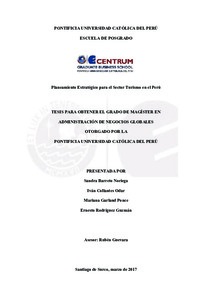| dc.contributor.advisor | Guevara Moncada, Rubén | |
| dc.contributor.author | Barreto Noriega, Sandra | es_ES |
| dc.contributor.author | Collantes Odar, Iván | es_ES |
| dc.contributor.author | Garland Ponce, Mariana | es_ES |
| dc.contributor.author | Rodríguez Guzmán, Ernesto | es_ES |
| dc.date.accessioned | 2017-03-17T21:42:45Z | |
| dc.date.available | 2017-03-17T21:42:45Z | |
| dc.date.created | 2017 | |
| dc.date.issued | 2017-03-17 | |
| dc.identifier.uri | http://hdl.handle.net/20.500.12404/8256 | |
| dc.description.abstract | A nivel mundial, el turismo crece en promedio al 7% y particularmente en
Sudamérica, al 8% a pesar de los constantes cambios macroeconómicos y problemas
políticos. En el Perú, el turismo ha venido creciendo en forma constante, aunque con cierta
desaceleración en los últimos años debido a ineficiencias en la promoción e inactividad en el
desarrollo de productos turísticos, llegando alrededor del 7%, aun sin mucho esfuerzo. En el
Plan Estratégico preparado para el Sector Turismo, encontramos que el Perú, reconocido
alrededor del globo por Machu Picchu (una de las 7 Maravillas del Mundo) y por su
gastronomía (Capital Gastronómica del Mundo), tiene múltiples recursos turísticos
inimitables, sin haber logrado convertirse en líder receptor de turistas internacionales ni en la
captación de sus divisas, siendo desplazado por países vecinos como Colombia y Chile. El
análisis del sector muestra una completa desarticulación de la gestión del turismo en el país,
un manejo inadecuado de recursos turísticos que no han sido puestos en valor y una
deficiente infraestructura de transporte y servicios básicos que podrían hacer que el sector
colapse en pocos años.
El análisis FODA realizado ha permitido proponer estrategias enfocadas a mejorar la
gestión del sector teniendo presente los intereses de cuatro stakeholders: el Estado, la
empresa privada, la población y el turista. En este sentido, se han propuesto objetivos a fin de
duplicar el número de turistas extranjeros en cinco años, sobre la base de alternativas de
modernización de la gestión del Estado mediante el uso de una organización de vanguardia,
que permita lograr objetivos mediante el empoderamiento de órganos transversales con
gestión matricial sobre las estructuras sectoriales del gobierno. Se observa al sector turístico
con optimismo, las entrevistas a especialistas del sector confirman que es posible lograr los
objetivos; los competidores no pueden duplicar nuestros múltiples atractivos culturales, pero
nosotros sí podemos aprender de sus éxitos | es_ES |
| dc.description.abstract | Whereas tourism worldwide grows in average 7%, in South America it rises by 8%
despite constant macroeconomic changes and political problems. In Peru, tourism has been
growing constantly however, it has recently slowed down due to an inefficient promotion and
lack of product development, still maintaining a 7% growth. In the present Strategic Plan for
the Tourism Industry we found that Peru is well recognized by Machu Picchu (one of the 7
Wonders of the Word) for its cuisine (Gastronomical Capital of the World) and has several
unique resources; however, it has not been able to become a leader in reception of tourists
and foreign currencies, being displaced by countries such as Colombia and Chile. The
analysis of the sector shows a disarticulated tourism management, an inadequate focus on
tourism resources that have not been put in value and poor transportation and basic services
infrastructure that can cause a collapse in the sector in a few years.
SWOT analysis allowed us to propose strategies focused on improving tourism
management, bearing in mind the interests of four stakeholders: the state, the private sector,
the population and tourists. This has allowed us to propose objectives to double the number
of foreign tourists arriving in Peru within five years by employing state-of-the-art alternatives
that would enable us to achieve our objectives through the empowerment of cross
government bodies with matrix management over the existing government structures. We
express optimism about the tourism industry, the experts interviewed have confirmed that the
objectives can be achieved. Our competitors may not duplicate our various cultural
attractions but we can surely learn from their success | es_ES |
| dc.language.iso | spa | es_ES |
| dc.publisher | Pontificia Universidad Católica del Perú | es_ES |
| dc.rights | Atribución-NoComercial-SinDerivadas 2.5 Perú | * |
| dc.rights | info:eu-repo/semantics/openAccess | es_ES |
| dc.rights.uri | http://creativecommons.org/licenses/by-nc-nd/2.5/pe/ | * |
| dc.subject | Turismo -- Perú | es_ES |
| dc.subject | Planificación estratégica | es_ES |
| dc.title | Planeamiento estratégico para el sector turismo en el Perú | es_ES |
| dc.type | info:eu-repo/semantics/masterThesis | es_ES |
| thesis.degree.name | Magíster en Administración de Negocios Globales | es_ES |
| thesis.degree.level | Maestría | es_ES |
| thesis.degree.grantor | Pontificia Universidad Católica del Perú. CENTRUM | es_ES |
| thesis.degree.discipline | Administración de Negocios Globales | es_ES |
| renati.advisor.orcid | https://orcid.org/0000-0002-4795-2557 | es_ES |
| renati.discipline | 413307 | es_ES |
| renati.level | https://purl.org/pe-repo/renati/level#maestro | es_ES |
| renati.type | https://purl.org/pe-repo/renati/type#tesis | es_ES |
| dc.publisher.country | PE | es_ES |
| dc.subject.ocde | https://purl.org/pe-repo/ocde/ford#5.02.04 | es_ES |






